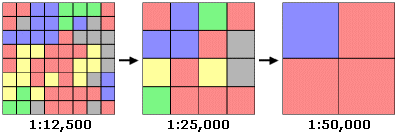Summary
Builds raster pyramids for your raster dataset.
This tool can also be used to delete pyramids. To delete pyramids, set the Pyramids Levels parameter to 0.
Illustration

Usage
Building pyramids improves the display performance of raster datasets.
You only need to build pyramids once per dataset. The pyramids will be accessed every time you display the raster dataset.
Pyramids will not be built for raster datasets that have less than 1,024 pixels in the row or column. Pyramids are not needed since the raster dataset is small enough, and building pyramids will not help increase the performance.
Wavelet compressed raster datasets, such as ECW and MrSID, do not need to have pyramids built. These formats have internal pyramids that are created upon encoding.
You can choose the compression type for your overview pyramid file in the Raster Storage Environments. Compression will create a smaller .ovr file. The IMAGINE format and older versions of ArcGIS will create reduced-resolution dataset (.rrd) files, where compression is not available.
The default pyramid compression will use the optimal compression type, given the type of data. You can manually choose to have LZ77, JPEG, or no compression.
JPEG compression can only be used with file formats that can store data according to the JPEG specifications. The list of supported raster dataset file formats lists which specification the JPEG format can support.
Syntax
BuildPyramids(in_raster_dataset, {pyramid_level}, {SKIP_FIRST}, {resample_technique}, {compression_type}, {compression_quality}, {skip_existing})| Parameter | Explanation | Data Type |
in_raster_dataset | The raster dataset for which you want to build pyramids. The input should have more than 1,024 rows and 1,024 columns. | Raster Dataset; Raster Layer |
pyramid_level (Optional) | Choose the number of reduced-resolution dataset layers that will be built. The default value is -1, which will build full pyramids. A value of 0 will result in no pyramid levels. To delete pyramids, set the number of levels to 0. The maximum number of pyramid levels you can specify is 29. Any value that is 30 or higher will revert to a value of -1, which will create a full set of pyramids. | Long |
SKIP_FIRST (Optional) | Choose whether to skip the first pyramid level. Skipping the first level will take up slightly less disk space, but it will slow down performance at these scales.
| Boolean |
resample_technique (Optional) | The resampling technique used to build your pyramids.
| String |
compression_type (Optional) | The compression type to use when building the raster pyramids.
| String |
compression_quality (Optional) | The compression quality to use when pyramids are built with the JPEG compression method. The value must be between 0 and 100. The values closer to 100 will produce a higher-quality image, but the compression ratio will be lower. | Long |
skip_existing (Optional) | Specify whether to build pyramids only when they are missing or regenerate them even if they exist.
| Boolean |
Derived Output
| Name | Explanation | Data Type |
| out_raster | The output raster dataset. | Raster Dataset |
Code sample
This is a Python sample for the BuildPyramids tool.
import arcpy
arcpy.BatchBuildPyramids_management(
"C:/data/img1.tif;C:/data/img2.img", "6", "SKIP_FIRST",
"BILINEAR", "JPEG", "50", "SKIP_EXISTING")This is a Python script sample for the BuildPyramids tool.
#Build Pyramids for multiple raster datasets in the workspace
#Skip the dataset that already has pyramid
#Build pyramids with compression and level setting
import arcpy
arcpy.env.workspace = "C:/Workspace"
inras = "image1.tif;image2.img;fgdb.gdb/image3"
pylevels = "6"
skipfirst = "SKIP_FIRST"
resample = "BILINEAR"
compress = "JPEG"
quality = "80"
skipexist = "SKIP_EXISTING"
arcpy.BatchBuildPyramids_management(
inras, pylevels, skipfirst, resample, compress,
quality, skipexist)Environments
- Pyramid
The pyramid level, pyramid compression, and resampling method does not apply to the IMG format.
- Parallel Processing Factor
Only supported for CRF format.
Licensing information
- Basic: Yes
- Standard: Yes
- Advanced: Yes